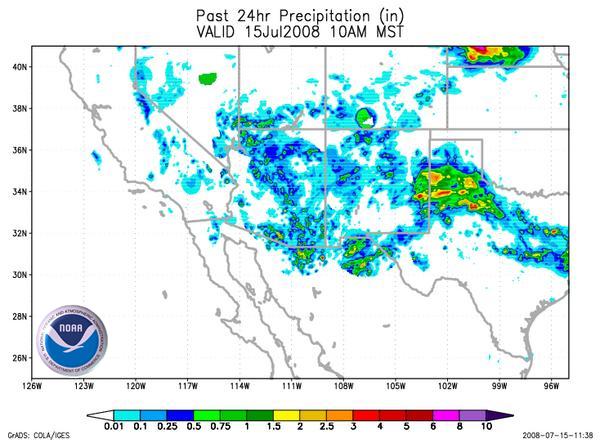The North American Monsoon Season Has Begun
(Courtesy NOAA/NWS – July 15, 2008)
Jeff Braun
Strong heating over the elevated (Mexican Plateau) desert southwest CONUS causes an area of low pressure to form known as a thermal low. Since the air pressure is relatively higher over the nearly adjacent ocean areas (Gulf of California and the Tropical Pacific) to the south and west, air flow (from high pressure to low pressure) begins to bring much more humid air toward the thermal low. Instability with this lower source (level) of moisture will help in developing thunderstorms in which rain can actually reach the ground (instead of just virga storms) which will additionally add to the boundary layer moisture and help in increasing thunderstorm chances for a prolonged period…at least until the cycle reverses in late summer/early fall (when land temperatures decrease some and the oceanic waters reach their maximum). Mid and upper level flow around high pressure aloft will also bring mid and upper level moisture into the region from the Gulf of Mexico.
Of course there can be much variability with the North American Monsoon as to where and how intense the moisture and thunderstorms tend to be. Where both the thermal and upper level lows/highs set up is of major importance and can mean the difference between all or nearly nothing. For example, while a good strong upper level ridge over the great plains area will help drive moisture into the southwest CONUS, a weaker ridge or one located further west over New Mexico or northern Mexico will keep the moisture located to the east and over the great plains. There are also a large number of other variables which can adversly affect the monsoon (see this short paper). Currently the thermal low is located over N to NWrn Mexico and the upper level ridge is centered over the Rio Grand Valley region of Texas/Mexico.
According to the the National Weather Service (NWS) out of Tucson, who track the North American Monsoon and its progress, the monsoon “officially” began here in the United States around the 2nd of July, 2008 (when average dewpoints in the Tucson region remain at least 54 deg F. or higher) – see the Monsoon Tracker page. Past 24 hour rainfall (as of July 15, 2008) is depicted at the top of the page and is very typical for an early season monsoon pattern.
For a more detailed and fascinating look at the North American Monsoon, see the NWS Tucson’s Monsoon section.
See also these papers:
Adams, D.K., and A.C. Comrie, 1997: The North American Monsoon. Bull. Amer. Meteor. Soc., 78, 2197-2213.
Douglas, M.W., R.A. Maddox, K Howard, and S. Reyes, 1993: The Mexican monsoon. J. Climate, 6, 1665-1667.
Carleton, et.al., 1990: Mechanisms of Interannual Variability of the Southwest United States Summer Rainfall Maximum. J. Climate, 3, 999-1015.
Higgins, R.W., Mo, K.C. and Yao, Y., 1998: Interannual Variability of the U.S. Summer Regime with Emphasis on the Southwestern Monsoon. J. Climate, 11, 2583-2606.
Barlow, M., Nigam, S., and Berbery, E.H., 1998: Evolution Of the North American Monsoon System. J. Climate, 11, 2238-2257.
Higgins, R.W., Chen, Y. and Douglas, A.V., 1999: Interannual Variability of the North American Warm Season Precipitation Regime. J. Climate, 12, 653-679.
Higgins, R.W. and Shi, W., 2000: Dominant Factors Responsible for Interannual Variability of the Summer Monsoon in the Southwestern United States. J. Climate, 13, 759-776.
Higgins, R.W. and Shi, W., 2001: Intercomparison of the Principal Modes of Interannual and Intraseasonal Variability of the North American Monsoon System. J. Climate, 14, 403-417.
Castro, C.L., McKee, T. B. and Pielke, R.A., 2001: The Relationship of the North American Monsoon to Tropical and North Pacific Sea Surface Temperatures as Revealed by Observational Analyses. J. Climate, 14, 4449-4473.
Vera, C. et. al., 2006: Toward a Unified View of the American Monsoon Systems. J. Climate, 19, 4977-5000.
Castro, C.L., Pielke, R.A. and Adegoke, J.O., 2007: Investigation of the Summer Climate of the Contiguous United States and Mexico Using the Regional Atmospheric Modeling System (RAMS). Part I: Model Climatology (1950-2002). J. Climate, 20, 3844-3865.
Castro, C.L., Pielke, R.A. and Adegoke, J.O., 2007: Investigation of the Summer Climate of the Contiguous United States and Mexico Using the Regional Atmospheric Modeling System (RAMS). Part II: Model Climate Variability. J. Climate, 20, 3866-3887.

